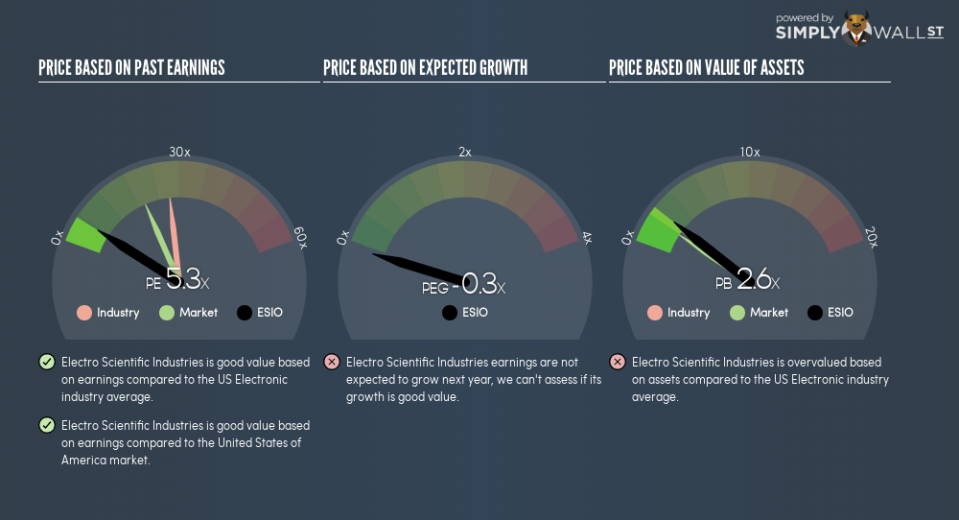What Does Electro Scientific Industries Inc’s (NASDAQ:ESIO) PE Ratio Tell You?

I am writing today to help inform people who are new to the stock market and want to begin learning about how to value company based on its current earnings and what are the drawbacks of this method.
Electro Scientific Industries Inc (NASDAQ:ESIO) trades with a trailing P/E of 5.3x, which is lower than the industry average of 27.3x. While ESIO might seem like an attractive stock to buy, it is important to understand the assumptions behind the P/E ratio before you make any investment decisions. Today, I will deconstruct the P/E ratio and highlight what you need to be careful of when using the P/E ratio.
See our latest analysis for Electro Scientific Industries
Breaking down the P/E ratio
P/E is often used for relative valuation since earnings power is a chief driver of investment value. It compares a stock’s price per share to the stock’s earnings per share. A more intuitive way of understanding the P/E ratio is to think of it as how much investors are paying for each dollar of the company’s earnings.
P/E Calculation for ESIO
Price-Earnings Ratio = Price per share ÷ Earnings per share
ESIO Price-Earnings Ratio = $22.54 ÷ $4.221 = 5.3x
The P/E ratio itself doesn’t tell you a lot; however, it becomes very insightful when you compare it with other similar companies. We want to compare the stock’s P/E ratio to the average of companies that have similar characteristics as ESIO, such as size and country of operation. One way of gathering a peer group is to use firms in the same industry, which is what I’ll do. ESIO’s P/E of 5.3 is lower than its industry peers (27.3), which implies that each dollar of ESIO’s earnings is being undervalued by investors. This multiple is a median of profitable companies of 24 Electronic companies in US including ProPhotonix, Hosiden and Surge Components. One could put it like this: the market is pricing ESIO as if it is a weaker company than the average company in its industry.
Assumptions to be aware of
However, there are two important assumptions you should be aware of. Firstly, our peer group contains companies that are similar to ESIO. If this isn’t the case, the difference in P/E could be due to other factors. For example, if you compared higher growth firms with ESIO, then its P/E would naturally be lower since investors would reward its peers’ higher growth with a higher price. The second assumption that must hold true is that the stocks we are comparing ESIO to are fairly valued by the market. If this does not hold, there is a possibility that ESIO’s P/E is lower because our peer group is overvalued by the market.
What this means for you:
If your personal research into the stock confirms what the P/E ratio is telling you, it might be a good time to add more of ESIO to your portfolio. But keep in mind that the usefulness of relative valuation depends on whether you are comfortable with making the assumptions I mentioned above. Remember that basing your investment decision off one metric alone is certainly not sufficient. There are many things I have not taken into account in this article and the PE ratio is very one-dimensional. If you have not done so already, I urge you to complete your research by taking a look at the following:
Future Outlook: What are well-informed industry analysts predicting for ESIO’s future growth? Take a look at our free research report of analyst consensus for ESIO’s outlook.
Past Track Record: Has ESIO been consistently performing well irrespective of the ups and downs in the market? Go into more detail in the past performance analysis and take a look at the free visual representations of ESIO’s historicals for more clarity.
Other High-Performing Stocks: Are there other stocks that provide better prospects with proven track records? Explore our free list of these great stocks here.
To help readers see past the short term volatility of the financial market, we aim to bring you a long-term focused research analysis purely driven by fundamental data. Note that our analysis does not factor in the latest price-sensitive company announcements.
The author is an independent contributor and at the time of publication had no position in the stocks mentioned. For errors that warrant correction please contact the editor at editorial-team@simplywallst.com.

 Yahoo Finance
Yahoo Finance 
